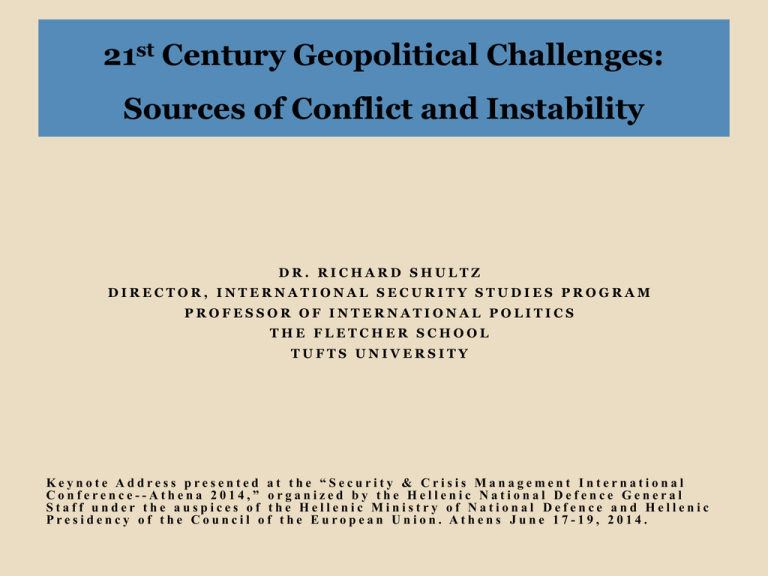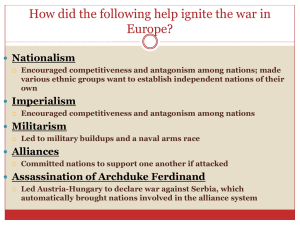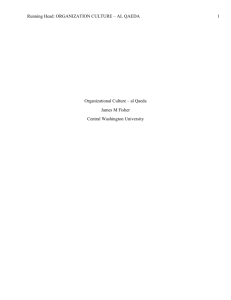21st Century Geopolitical Challenges
advertisement

21st Century Geopolitical Challenges: Sources of Conflict and Instability DR. RICHARD SHULTZ DIRECTOR, INTERNATIONAL SECURITY STUDIES PROGRAM PROFESSOR OF INTERNATIONAL POLITICS THE FLETCHER SCHOOL TUFTS UNIVERSITY Keynote Address presented at the “Security & Crisis Management International Conference--Athena 2014,” organized by the Hellenic National Defence General Staff under the auspices of the Hellenic Ministry of National Defence and Hellenic Presidency of the Council of the European Union. Athens June 17-19, 2014. 21st Century Crisis Management The concept of crisis management had its origins in the Cold War. It was understood as a sequence of interactions between two or more states engaged in a severe conflict, short of war, but with the danger of escalating to war. Since the Cold War’s end international and regional crises have diverged from this pattern. An array of new forms of instability has generated new crises and crisis management challenges. There appears to be no end in sight to this geopolitical turbulence. New security risks that have emerged in the first decade and a half of the 21st century are likely to continue in the years ahead. The sources of instability and crisis that likely will impact this geopolitical landscape will be highlighted in the presentation along with the irregular security challenges they will pose. 2 Conflict and Security Landscape: An Overview The 21st century security landscape will consist of crises that are prolonged and involve a range of non-state and state actors who will employ irregular and asymmetric warfare instruments in pursuit of their political objectives. This lecture will underscore major sources of irregular conflict, identify those actors fostering this instability, and describe the irregular warfare methods they will employ to carry out their activities. Critical to making sense of today’s security environment is recognition that conflict and war between nation states will be more the exception than the rule in the 21st century. Therefore, understanding evolving patterns of irregular conflict is essential. These challenges are likely to persist for the remainder of this decade and into the next. Managing the crises they generate will be very demanding but indispensable. 3 The nature of instability has evolved since the end of the Cold War and in the shadow of 9/11. Irregular conflicts have predominated in many regions of the world. Security challenges are increasingly arising from non-state armed groups and authoritarian regimes who employ irregular tools and techniques in pursuit of their political objectives. And in many instances they are exploiting fragile states. Often these state and non-state actors act alone. But at other times they develop co-operative relationships ranging from de facto coalitions to loose affiliations. State and non-state actors take advantage of fragile states that cannot control their territory, maintain a monopoly over the use of force, or perform core government functions. Many fragile states today are weak semi-democratic experiments that face serious challenges emanating from their own shortcomings as well as from armed groups and authoritarian states aligned against them. Illustrative examples include Ukraine, Georgia, Moldova, Mexico, Colombia, the Philippines, Nigeria, Afghanistan, Pakistan, and several of the states touched by the Arab Spring. 4 In the 21st century, state and non-state actors will seek to achieve their objectives by waging irregular warfare. They will employ a range of indirect and unconventional tactics to gain influence and/or control over territory and populations. These developments do not appear to be temporary. Rather, they are illustrative of today’s security landscape. Countering these trends and the instability they foster will constitute major crisis management challenges. 5 ABCs of Irregular Warfare Irregular warfare (IW) can take different forms depending on who conducts it (actors), how they conduct it (methods), and why they conduct it (purpose). IW is a prolonged struggle among state and non-state actors for influence and/or control over a relevant population. It is a political clash of interests in which a variety of means--violent and nonviolent--are employed to subvert, coerce, erode, and exhaust an adversary. IW is population-centric conflict or what has been described as a “war amongst the people.” What makes IW different is its operational focus--a relevant population, and strategic purpose--to gain control or influence over that population. State and non-state actors seek to undermine the authority, legitimacy, and credibility of states they consider adversaries. They do so by employing a range of these indirect and asymmetric tactics, techniques and procedures. IW strategies employ a mix of irregular, disruptive, sometimes traditional, and possibly even catastrophic capabilities. 6 7 Conflict and Security Landscape: A Closer Look Part One Summation of what we know and what can be generalized about armed groups, authoritarian states and their use of irregular conflict strategies. Part Two Examination of three possible crisis flashpoints generated by: the resurgent al Qaeda network; Russia’s active measures revival; and Iran’s covert paramilitary campaigns. 8 Part One Armed Groups Authoritarian States Irregular Conflict 9 Armed Groups: A Persistent Trigger of Crisis and Irregular Conflict ● Armed groups have proliferated in number and operational capacity since the Cold War ended. Many are capable of causing geopolitical damage in their own territory and in some cases beyond. ● They are diverse in terms of subtypes--terrorists, insurgents, criminals, militias—and vary in vision, mission, and means employed. But many share the following common characteristics that make them difficult to contain and degrade. --Armed groups are iceberg-like organizations, with below-the-waterline clandestine operational units that are networked and difficult to detect. --Armed groups place a high premium on intelligence and security tools to protect themselves from penetration by states or rival armed groups, as well as penetrate and manipulate these adversaries. --They use protracted irregular political and paramilitary tools to gain control over territory and population. 10 --Some armed groups have grandiose worldviews stated in ideologies they propagate and seek to impose on others. --Many are skilled at strategic information operations for disseminating their narrative and carry out other operationally-focused information activities. They create communications systems to do so. --To gain local and transnational support armed groups construct narratives that justify their extreme actions. --The use or threat of violence is everyday business, to be employed as a routine tool, not a last resort. --The population’s support, submission, or passive acceptance is essential for an armed group to operate. --They all challenge the authority, power and legitimacy of the state--to some extent. 11 ● The capacity of armed groups to transform and to establish linkages with state and other non-state actors greatly complicates the ability of security services to understand them. In particular this is the case for linkages between international organized crime (IOC) and other types of armed groups. ● In other cases linkages take the form of arrangements between states and armed groups. ● Armed groups capacity to acclimate and adjust often allows them to outpace larger and more powerful state adversaries. Illustrative of this capacity, as will be highlighted later, has been the adaptation and re-emergence of the al Qaeda movement between 2011 and 2014. 12 Skillful Authoritarian States: Destabilizing through Irregular Tactics, Techniques and Procedures ● Several authoritarian states adhere to strategic worldviews derived from ideational narratives that shape their views of competition and conflict, and how to prosecute it to achieve their objectives. ● They challenge the prevailing status quo which they view as a key obstacle to achieving their goals. ● However, the prevailing international status quo with its concomitant contemporary military force imbalances causes them to rely on irregular tactics, techniques and procedures to project power and influence. ● This includes the formation of state and non-state coalitions to include the mobilization of proxies to further their agenda. 13 Authoritarian states can challenge the prevailing status quo by employing a variety of means but their weapons of choice presently are irregular instruments. These tools include, most importantly, covert political and paramilitary tactics, techniques and procedures. With respect to the former, it include covert political influence operations through the provision of assistance to internal opposition groups and diaspora communities in states of importance. Covert information campaigns, as well as political intimidation, bribery, and other techniques of intelligence tradecraft are also employed. Covert paramilitary methods entail providing armed groups with funds, weapons, training and advisors to improve their capacity to carry out irregular warfare operations against states of importance. This can also include providing sanctuary and safe havens to armed groups. Authoritarian states are developing new irregular means to enhance their inventory of capabilities. This includes the development by authoritarian states of cyber attack as a part of their irregular warfare operations. 14 In the 21st century authoritarian states are advancing the use of instruments that former SACEUR, Admiral Stavridis, has described as part of “The New Triad.” The old strategic triad is well known, but what constitutes the new one? According to the former SACEUR , the "New Triad consists of special operations forces, unmanned vehicles, and cyber-capabilities…Taken together, the sum of their impact will be far greater than that of each of the parts when used alone.” Admiral Stavridis discusses how each part of “The New Triad’” will be an important capability for the US and its allies to develop to help insure their security in the years ahead. But, he notes, we still need to think through the strategic uses and impact of each. Skilled authoritarian states, as will be illustrated in the case of Russia and Iran, appear to have already grasped the strategic importance of the tools of “The New Triad.” And they are imbedding them in irregular warfare strategies to challenge the existing status quo in regions in which they seek to predominate. 15 Part Two Crisis Scenarios Al Qaeda Network Resurgent Russian Active Measures Revival Iran’s Covert Paramilitary Campaigns 16 Al Qaeda Network Resurgent An Evolving and Adapting Millenarian Movement ● Since Osama bin Laden’s death there has been much debate and disagreement over whether al Qaeda is evolving or devolving, in ascendency or decline. ● In 2011 al Qaeda was judged “on the ropes” and nearing defeat by Washington. But over the next three years it appears to have re-created itself as a complex and adaptive network of affiliated and associated groups that exist as an international ideational movement. ● Today, al Qaeda is comprised of a number of regional and national level groupings. To varying degrees each is aligned with AQ’s ideology of Salafi Jihadism and its goal of establishing an extremist version of Shari’a governance. ● As a millenarian movement, those in the al Qaeda network see the world through Manichaean lenses--a holy war between good and evil. They seek to transform the status quo in the Muslim world and return it to an idealized past. 17 ● Today, different constituent elements of this transnational movement are conducting irregular warfare operations on more territory that at any other time in al Qaeda’s existence. ● One of the unintended consequences of the Arab Spring was that it provided an additional context for the expansion of the al Qaeda network. ● By 2013 extremists that identify with al Qaeda’s ideology were fighting in Nigeria, Mali, across the Maghreb, in several Middle Eastern countries to include Iraq and Syria, north into the Caucasus region, south into the Arabian Peninsula, and east to the states of South and Central Asia. ● The slides that follow illustrate the resurgence of al Qaeda and delineate its various parts. The impact of its resurgence on the wide span of territory it now traverses has been to create a significant zone of violent instability and conflict, the implications of which have yet to be fully realized in the Western Democracies. ● To be sure, these developments will in the years ahead have the potential to generate crises with serious security and economic ramifications that will be difficult to ignore. 18 The Al Qaeda Network 2014 The al Qaeda network in 2014 can be divided into three elements with varying degrees of connectivity. These include, according to the Critical Threats Project: Al Qaeda Core Also known as al Qaeda central, it is based in Pakistan and is led by the al Qaeda emir. This leadership group been degraded over the last decade but remains intact. AQ Affiliates These are groups officially recognized by the Core as officially part of the network. Each has adopted the ideology and are aligned with the Core. There are six recognized affiliates: al Qaeda in Iraq, al Qaeda in the Islamic Maghreb, al Qaeda in the Arabian Peninsula, Jabhat al Nusra, al Shabaab, and the Islamic Emirate of the Caucasus. They fight locally and regionally but are aligned with AQ’s global mission. AQ Associates These are groups that are ideologically aligned with AQ and adopt its operational signatures but have not been officially recognized by the core leaders. There are a number of them. They adhere to AQ’s ideology, and exhibit common characteristics. 19 20 Arc of Instability and Crisis 21 Russia’s Active Measures Revival Irregular Warfare Operations in the Ukraine Cold War Redux--Soviet Covert Operations ● During the Cold War, covert operations or what the USSR termed Active Measures was considered a major weapons system for conducting irregular warfare. ● Soviet active measures were utilized to influence and manipulate events and behavior in foreign societies. An array of tools were employed to: influence the policies of other governments; undermine or build up leaders and institutions in those states; disrupt relations between states; undermine opponents through support of opposition political and/or armed resistance groups. ● Active measures tools included: forged documents to discredit opponents; agents of influence to promote Soviet goals through foreign journalists, labor leaders, government officials, academics; creation of front organizations to influence political developments; clandestine information operations; support to opposition political parties and movements in foreign countries; and training and support to insurgent and terrorist organizations. 22 ● Within the Soviet apparatus, primary responsibility for the conduct of secret political warfare operations was assigned to specialized sections within the KGB. Under the leadership of KGB chief Andropov these activities were refined and accelerated. A second key institution was the CPSU’s International Department. ● Active measures also included paramilitary support to insurgent and terrorist organizations to improve their effectiveness. Assistance included provision of arms, training, and advisory support. ● Paramilitary training in irregular warfare and specialized tactics was the responsibility of both the GRU and KGB. Assistance could take place in the field or in special schools directed by Spetsnaz or special designation units. ● The capabilities of Soviet client states supplemented Soviet active measure capabilities. 23 Crimea Annexation ● The collapse in February of the Yanukovitch government at the hands of a civil resistance movement threw the Ukraine into turmoil and created a crisis for Russia. ● The EU brokered agreement to end the protests and adopt a roadmap leading to early presidential elections, which Russia grudgingly agreed to, proved ineffectual. The Ukrainian parliament passed a bill of impeachment, Yanukovitch fled, and a new government formed. ● These developments were seen by Moscow as leading to the loss of the Ukraine, at minimum, as a friendly and attendant client state. It claimed that the new government was comprised of extremists who were threatening the safety of the Russian minority in Ukraine. ● Moreover, the new Ukraine government potentially could pose a threat to the basing of the Russian Black Sea fleet in Crimea. ● Quickly, local groups began to emerge in Crimea calling for separation from Ukraine. They seized the Supreme Council of Crimea and the Council of Ministers buildings. Next, pro-secession militia established checkpoints to control the territory separating Crimea from rest of Ukraine. 24 ● By March 1, the Supreme Council of Crimea dissolved the Council of Ministers, selected the Russian Unity party head as prime minister, and requested Putin ensure public safety in Crimea. This led to Russian military support for local militias now called self defense forces. ● In March the Supreme Council of Crimea issued a Declaration of Independence, and requested full accession to Russia if this course of action received the most referendum votes. ● To prepare for the referendum, Ukrainian broadcast networks were replaced by state-controlled channels from Moscow, dissent was suppressed by local masked gangs, and elite Russian units out of uniform appeared at strategic locations. ● The outcome of this “election operation” was 95% of the votes supported unification with Russia, and a Treaty of Accession was shortly thereafter finalized. ● When the same activities began to take place in Eastern Ukraine, various assessments described these developments as asymmetric warfare, shadow war, indirect warfare, non-linear warfare and “Putin Reinventing Warfare.” Actually, it was an adaptation of the old KGB playbook. 25 Crimea Annexation: Active Measures on Display ● Opening Gambit--Insert intelligence operatives (from the FSB or SVR) to instigate and assist a local political movement call for secession from Ukraine to protect the Russian ethnic-linguistic identity which was said to be violently repressed by extremist/fascist gangs directed by Kiev. ● Insert special forces either in mufti or wearing camouflage without insignia (old Maskirovka tactics) to assist local militias comprised of separatists, criminal elements, and outside provocateurs to use force to intimidate those opposed to secession. ● Supply local militias with weapons to attack police stations and other government offices to take control and occupy them. ● Use the violence instigated by the Spetsnaz directed militias as a pretext to deploy Russian forces to the region for a possible “peacekeeping” intervention. Intended to blunt any response by Kiev. ● Initiate a political and psychological warfare campaign using media and internet platforms to report violence against the Russian population in Crimea and elsewhere in the eastern and southern Ukraine by gangs directed by fascist Kiev. [These activities reflected the kinds of misinformation and disinformation techniques that were the forte of the KGB] 26 ● Project the Kremlin’s political misinformation through non-governmental institutions to include the Orthodox Church, entertainment television, business groups and public relations firms. ● End Game--Election operation in Crimes. Political action to undermine and intimidate opponents of annexation preceded the vote which resulted in unification with Russia. »» Traditional Military Methods--Active Measures Methods* --From destruction operations to political influence operations. --From direct annihilation to internal disruption and subversion. --From war with weapons and technology to war by indirect means. --From direct clashes to political, psychological, paramilitary operations. The extension of these methods into eastern and southern Ukraine will have the potential to generate crises with serious security and economic ramifications for the EU and NATO. * Janis Berzins, Russia’s New Generation Warfare in Ukraine: Implications for Latvian Defense Policy (National Defence Academy of Latvia, Center for Security and Strategic Research, April 2014). 27 Iranian Covert Action and Paramilitary Operations Irregular Warfare and Special Activities Iran likewise employs covert political and paramilitary operations as core instruments of statecraft to pursue its goal of political predominance in the Gulf region. Covert political influence operations are employed to sway the internal balance of power in Iran’s favor in states in this region through secret penetration and assistance to Shi’a Islamist opposition parties and movements. Iran also provides covert paramilitary assistance including weapons, training and advisory support to terrorist, guerrilla and militia organizations to destabilize states in this region. Iran employed these irregular warfare tools effectively in Iraq to achieve its objectives during the US intervention and after its exit. It likewise is relying on these instruments to assist the regime in Syria successfully manage its civil war. The Gulf will remain a critical region for the foreseeable future. Consequently, these Iranian activities are likely to generate crises with potentially serious security and economic ramifications for the EU and NATO. 28 Organizational Apparatus for Irregular Warfare Operations The importance of covert political and paramilitary operations as central instruments of statecraft is illustrated by the considerable institutional capabilities Iran retains for these activities. The Islamic Revolutionary Guard Corps Quds Force (IRGC-QF) functions as a hybrid special operations organization that can execute both paramilitary missions and political influence operations. It maintains a wide array of capabilities and facilities for these special activities. Elements of the Quds Force has been deployed widely to support Iranian policy goals in Lebanon, Iraq, Syria, the Palestinian territories, and the Gulf states. The Ministry of Intelligence and Security (MOIS) maintains an array of capabilities that complement and reinforce Quds Force political and paramilitary operations. The Iranian apparatus for executing special activities also includes the assets of a major proxy organization--Hezbollah. 29 Lebanon A major achievement for the Quds Force and MOIS has been in Lebanon where they facilitated the creation and evolution of Hezbollah as a major proxy. Since the early 1990s Iran fostered the development of Hezbollah through generous funding, supply of weapons, and irregular warfare training in facilities in Iran and in the Beqa Valley. At different times Quds advisors were integrated into Hezbollah’s paramilitary command structure to include during the immediate years prior to its 2006 war with Israel. At that time the IRGC-QF deployed a contingent force to south Lebanon to prepare Hezbollah for irregular warfare operations against Israel. Hezbollah has supported Iranian policy in several ways. In the past it carried out terrorist attacks abroad for Tehran. More recently it has played an integral role in IRGC-QF programs to support and train extremist groups, most notably in Iraq. Finally, Hezbollah has deployed forces to Syria under the direction of the IRGC-QF chief of staff. 30 Iraq A second major example of the successful use of covert operations through the Quds Force was in Iraq, following the U.S. intervention. The IRGC-QF campaign was a major irregular warfare undertaking that illustrates the Iranian capacity for employing covert paramilitary and political instruments of statecraft. Iran exploited its long standing political linkages with Shi’a sectarian groups in Iraq. IRGC-QF operatives moved into Iraq in 2004 to foster resistance to US forces through assistance to existing Shi’a militia groups but also by creating new groups dependent on Iran for training and assistance. Tehran’s paramilitary operations included the deployment of Hezbollah operatives, who trained Shi’a militia in three camps in Iran. With the US withdrawal from Iraq, Iranian covert programs were re-calibrated, employing political action operations to bring together a large enough Shi’a coalition to take control of the Iraq government. While not without shortcomings, Iran’s covert paramilitary and political action operations in Iraq illustrate its successful use of these instruments against far stronger opponents. 31 Questions






